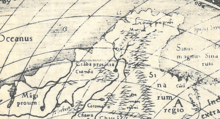Locach
Lochac, Locach or Locat is a country far south of China mentioned by Marco Polo. The name is widely believed to be a variant of Lo-huk: the Cantonese name for the southern Thai kingdom of Lopburi (also known as Lavapura and Louvo), which was a province of the Khmer Empire at the time.[lower-alpha 1]
However, it has also been suggested that Polo or his sources in China were referring to other locations or conflating several different places as Lochac.
Theories regarding Lopburi and the Khmer Empire
Marco Polo may also have used "Locach" to mean the Khmer Empire in general.[2]:362 One piece of evidence for this is the "golden towers" that Polo reported in Locach, which were more likely inspired by the golden spires of Angkor Wat, the capital of the Khmer Empire (than the Lopburi of his time). As Zhou Daguan, the ambassador sent by the Yuan court to Cambodia in 1296 commented: “These [golden towers] are the monuments that have caused merchants from overseas to speak so often of ‘Zhenla [Cambodia] the rich and noble’.”[3]:2
The imprisonment of a Mongol emissary by the Khmer ruler Jayavarman VIII in 1281[3]:xviii–xix:2 would have been ample justification for Polo's allegation of the inhumanity of its people. He said that Locach was "such a savage place that few people ever go there" and that "the king himself does not want anyone to go there or to spy out his treasure or the state of his realm". Polo also noted an abundance of elephants in Locach; in the Chinese annals, Locach was notable for sending elephants as tribute.[4]
Subsequent maps and theories
A Pentan mentioned by Polo appears to be the island of Bintan. Likewise Malaiur was the old Tamil name for the Sumatran city of Jambi (and is the origin of the national name Malay).[5]
A mistranscription of Locach, Beach, originated with the 1532 editions of the Novus Orbis Regionum by Simon Grynaeus and Johann Huttich, in which Marco Polo’s Locach was changed to Boëach, which was later shortened to Beach.[6] Abraham Ortelius inscribed on his 1564 world map: Latinum exemplar habet Boeach sed male ut fere omnium: Nos italico usi fuimus (A Latin version has Boeach, but mistakenly: like almost everyone we have used the Italian).[7]
On Gerard Mercator's 1538 map of the world, Locat is situated in Indochina, south of Champa (Ciamba).[8]

On Guillaume Le Testu’s 1556 Cosmographie Universel, Locach appears to be named La Joncade – an island off a promontory of the southern continent, Terre australle, to the eastward of Grande Jaue, a northward-extending promontory of the Terre australle (Terra Australis) to the south of Java.[9] However, some scholars see in La Jocade a resemblance to the North Island of New Zealand.
In 1769, the East India Company hydrographer, Alexander Dalrymple, stated that the northern part of New Holland "seems to be what Marco-Polo calls Lochae".[10]
Paul Wheatley, after G. Pauthier (who reads Locach as Soucat),[11][12] and Henry Yule (1866),[13] believe that the place referred to was in Borneo, such as: West Kalimantan, Sukadana or Lawai (arch. Laue; Lawai, near the Kapuas River).
Footnotes
References
- Gerini, Gerolamo Emilio; Royal Asiatic Society of Great Britain and Ireland (1909). Researches on Ptolemy's geography of Eastern Asia (further India and Indo-Malay archipelago). Asiatic Society Monographs. 1. London: Royal Asiatic Society.
- Marsden, William (1818). The Travels of Marco Polo. London.
- Chou Ta-kuan (周達観) (1993). 風土記 [Customs of Cambodia]. Translated by Pelliot, Paul; d’Arcy Paul, J. Gilman. Bangkok: Siam Society.
- Paul Pelliot, Notes on Marco Polo, Paris, Imprimerie Nationale, 1963, Vol.II, p.554, note 2. Paul Wheatley, “Lochac Revisited”, Oriens Extremus, vol.16, 1969, pp.85- 110. Luohu 羅 斛 is also described in the Wubei Zhi (武 備 志 Military Records) edited by Mao Yüan-yi 茅元儀, containing the Mao Kun Map, dating from the Yuan Dynasty ("Zhan Du Zai", chapter 236, "Examination of All Countries Beyond the Seas: Xianluo", pp.10256-8); See also Ma Huan, Ying-yai sheng-lan: The Overall Survey of the Ocean's Shores [1433], translated by Feng Ch`eng-Chun with introd. notes and appendices by J. V. G. Mills, Cambridge [Eng.], Cambridge University Press for the Hakluyt Society, 1970.
- Sir Henry Yule (ed.), The Book of Ser Marco Polo, London, Murray, 1921, Vol.II, pp.280-283
- (Simon Grynaeus and Johann Huttich, Novus Orbis Regionum, Basel and Paris, 1532, Marco Polo cap.xi, “De provincia Boëach”; cited in Thomas Suarez, Early Mapping of Southeast Asia, Hong Kong, Periplus, 1999, p.160.)
- Abraham Ortelius, Nova Totius Terrarum Orbis juxta Neotericorum Traditiones Descriptio, Antwerp, 1564, in Günter Schilder, Monumenta Cartographica Neerlandica, Alphen aan den Rijn, Uitgevermaatschappij Canaletto, 1986, Vol.2.
- World Map on Double Cordiform Projection, Gerardus Mercator (1512–94).
- Guillaume Le Testu, Cosmographie Universel, 1556, 4me projection, Clémence Lévy and Poerrette Crouzet (eds.), New Worlds, Paris, Bibliothèque nationale de France/ Bibliothèque de l’Image, 2012, pp.60-61.
- Alexander Dalrymple, A Plan for Extending the Commerce of this Kingdom, and of the East India Company, London, 1769, p.92; cited in Arthur Wichmann, Nova Guinea, Vol.1, Entdeckungsgeschichte von Neu-Guinea, Leiden, Brill, 1909, pp.6-7.
- Paul Wheatley, “Lochac Revisited”, Oriens Extremus, vol.16, 1969, pp. 85-110 (at JStor).
- Guillaume Pauthier, Le Livre de Marco Polo, Paris, Firmin Didot, 1865, p. 563.
- Henry Yule, Cathay and the Way Thither, VI. Ibn Battuta, note G (1866, vol. 2, p. 521).
Further reading
- Robert J. King, "Marco Polo’s Java and Locach on Mercator’s world maps of 1538 and 1569, and globe of 1541", The Globe, no.81, 2017, pp.41-61.
- Robert J. King, “Finding Marco Polo’s Locach”, Terrae Incognitae, vol.50, no.1, April 2018, pp.1-18.